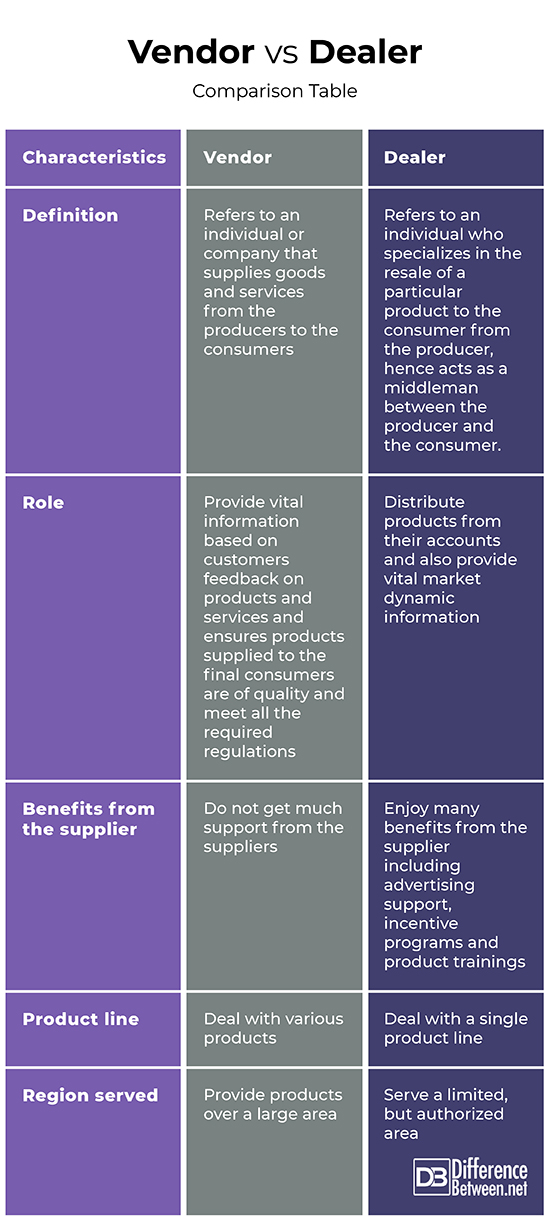Difference Between Vendor and Dealer
The supply chain, which involves a network of the organization, resources, activities, technology and products and services, is one of the main aspects of any business, as goods and services need to be availed to the consumers from the producers. An efficient supply chain reduces operating costs, boosts customer service, and improves organizational finances, while also creating job opportunities, not to mention boosting economic growth. Although the main players are the producers and consumers, the supply chain cannot be complete without other parties such as distributors, vendors, and retailers. In this process, several intermediaries are involved, such as vendors and dealers, who act as middlemen. While most people use the two terms simultaneously, they have differences.
Who is a Vendor?
Usually the last person in the supply chain, this is an individual or company that supplies goods and services from the producers to the consumers. Apart from the provision of vital information based on customer’s feedback on products and services, vendors ensure products supplied to the final consumers are of quality and meet all the required regulations. Vendors can supply other businesses, customers or the government.
Who is a Dealer?
This is an individual who specializes in the resale of a particular product to the consumer from the producer, hence acts as a middleman between the producer and the consumer. Although dealers enjoy many benefits from the supplier including advertising support, incentive programs, and product training, they serve a limited but authorized area. Dealerships also come with a lot of competition from other dealers; hence they have to invest in consumer incentives such as customer service, frequent discounts, and sales.
Similarities between vendor and dealer
- Both act as feedback agents to the supplier
- Both act as middlemen between the producer and the consumer.
Differences between vendor and dealer
1.Definition
A vendor refers to an individual or company that supplies goods and services from the producers to the consumers. On the other hand, a dealer refers to an individual who specializes in the resale of a particular product to the consumer from the producer, hence acts as a middleman between the producer and the consumer.
2.Role
Vendors provide vital information based on customers’ feedback on products and services and ensure products supplied to the final consumers are of quality and meet all the required regulations. On the other hand, dealers distribute products from their accounts and also provide vital market dynamic information.
3.Benefits from the supplier
While vendors do not get much support from the suppliers, dealers enjoy many benefits from the supplier including advertising support, incentive programs, and product training.
4.Product line
While vendors deal with various products, dealers deal with a single product line.
5. Region served
Vendors provide products over a large area while dealers serve a limited, but authorized area.
Vendor vs. Dealer: Comparison Table
Summary of Vendor and Dealer
While a vendor refers to an individual or company that supplies goods and services from the producers to the consumers, a dealer refers to an individual who specializes in the resale of a particular product from the producer to the consumer. Although both act as intermediaries between the producers and consumers while also providing vital market information, they differ in terms of the product lines, areas served as well as the benefits they gain from the producers. Both, however, are important in availing goods to consumers.
- Difference Between Profit Center and Investment Center - July 2, 2022
- Difference Between Anti-Trust and Anti-Competition - June 6, 2022
- Difference Between Stocktaking and Stock Control - June 6, 2022
Search DifferenceBetween.net :
Leave a Response
References :
[0]Image credit: http://www.thebluediamondgallery.com/handwriting/images/vendor.jpg
[1]Image credit: http://www.thebluediamondgallery.com/tablet/images/dealer.jpg
[2]Mikkola J & Larsen T. Managing the Global Supply Chain. Copenhagen Business School Press DK, 2007. https://books.google.co.ke/books?id=h1wg6KhurO8C&printsec=frontcover&dq=Difference+between+vendor+and+dealer&hl=en&sa=X&ved=0ahUKEwio9KSDxtDkAhWSiFwKHfLTBXE4ChDoAQhPMAc#v=onepage&q&f=false
[3]Miori V & Lawrence K. The Supply Chain in Manufacturing, Distribution, and Transportation: Modeling, Optimization, and Applications. CRC Press, 2010. https://books.google.co.ke/books?id=lWzRVOwmNJMC&printsec=frontcover&dq=Difference+between+vendor+and+dealer&hl=en&sa=X&ved=0ahUKEwiQ1JeQxtDkAhVKQUEAHe1_CsM4FBDoAQhEMAQ#v=onepage&q&f=false
[4]Andreasen Alan. Ethics in Social Marketing. Georgetown University Press, 2001. https://books.google.co.ke/books?id=WeFKuorUjx4C&printsec=frontcover&dq=Difference+between+vendor+and+dealer&hl=en&sa=X&ved=0ahUKEwiQ1JeQxtDkAhVKQUEAHe1_CsM4FBDoAQg-MAM#v=onepage&q&f=false



